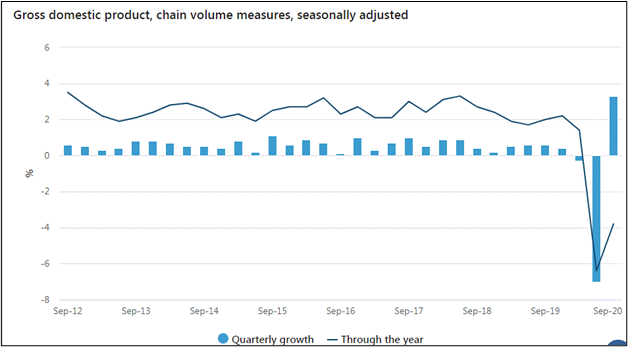Summary
- Australian economy posts 3.3% growth in the September quarter as it bounces back from the recession.
- Rise in household spending to 7.9% helped the economy to expand in September quarter.
- However, household saving to income ratio fell to 18.9 per cent from 22.1 per cent reported in the June quarter.
The Australian economy bounced out of recession as the economy expanded by 3.3 per cent in the September quarter. The gross domestic product (GDP) growth had contracted 7 per cent in the June quarter, the worst in Australian Bureau of Statistics (ABS) records since 1959, largely on account of coronavirus pandemic. The uptick is driven by higher household spending on goods and services which rose 7.9 per cent.
Similarly, spending on services such as hotels, cafes, health, recreation, among others was also up 9.8 per cent in the quarter under review. The demand for goods was up 5.2 per cent, according to the recent data. Victoria was the only state to have seen fall in household spending to 1.2 per cent amid tighter coronavirus induced restrictions.

Image Source: © Kalkine Group 2020
The compensation of employees also surged 2.3 per cent due to an increase in the worked hours. Part-time employment recorded an increase too. The household saving to income ratio was recorded at 18.9 per cent, a decline from 22.1 per cent in the June quarter.
READ MORE: Economic Charter: Australia's Current Account and House Approvals Data Out
The net trade reduced 1.9 percentage points from GDP. It was the largest reduction since the September quarter of 1980. Rise in import of goods and services reflected the rise in the demand for consumption goods as coronavirus induced restrictions eased. However, weaker demand for Australian mining commodities and restrictions on travel led to fall in exports of goods of services.

Image source: ABS, September quarter GDP report, dated 2nd December 2020
Commenting on the September quarter GDP data, Head of National Accounts at the ABS, Michael Smedes, said despite robust quarterly growth in household spending, the level in the September quarter was 6.8 per cent as against the December quarter of 2019. The economic activity declined 3.8 per cent through the year to September quarter, after a 7 per cent decline in June quarter and a partial recovery in September quarter, Smedes added.
Meanwhile, the Reserve Bank of Australia on Tuesday kept the cash rate at 0.1 per cent. Sharing his views, Governor Philip Lowe said that it may take until the end of 2021 for the economy to hit 2019 output levels. Even the unemployment may remain more than 6 per cent in the coming two years, Lowe added. The economic recovery is expected to be uneven, bumpy and drawn out, he warned.
.jpg)


